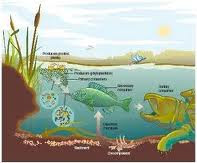 |
| (d)Noise pollution |
 |
| (a)Air pollution |
 |
| (c)Land pollution |
 |
| (b)Water pollution |
Air pollution:Air pollution is an disequilibrium condition of amiability air quality by the introduction of foreign element from either anthropogenic or natural sources.In other words,it an atmospheric condition in which certain substance are present in such concentrations that can produce undesirable effect on man and his environment.This substance include gases like sulfur oxides, hydrocarbon,smoke,dust,aerosols,radioactive materials, etc
Water pollution:Direct disposal of solid and liquid waste,use of chemical fertilizer,disposal of dead bodes in the source of water like pound,lake,rivers pollute the water.Water pollution denotes any type of contamination either biological or chemical in the pure state of water.It is an physical or chemical change in surface or ground water that can adversely affect living organisms.Polluted water however,is turbid,unpleasant,bad smell,unfit for drinking,bath,and washing or other purposes.It is harmful and vehicle of many diseases as cholera,dysentery,typhoid,etc
Land pollution:Any substance that are not common component of soil but their present adversely affect the property of soil is termed as soil or land pollution.There are various material that affect on physical,chemical,biological properties of soil.Hence it affect the productivity of soil.Common pollutant of soil are non-degradable solid wastage of the industries,domestic used material such as plastic bag,glasses,metallic items,etc.Many of the chemical effluents emitted into air such as lead,sulfur,etc.deposit in the earth and ultimately that pollute the soil.Thus,land pollution has also been a serious problems at present.
Noise pollution:Noise is commonly define as unwanted and unpleasant sound that cause discomfort.It is also known as "wrong sound,in wrong place at the wrong time".Because of the development of machinery,industry and technology noise has been a inseparable part of our life.Sound intensity is measure in units is called decibel.Sound beyond 80 db is considered as sound pollution.It affect the health of human being adversely





















